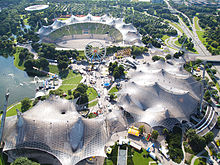1972 Summer Olympics
The design of these stadia was considered revolutionary, with sweeping canopies of acrylic glass stabilized by metal ropes, used on such a large scale for the first time.[8] The event was overshadowed by the Munich massacre in the second week, in which 11 Israeli athletes and coaches and a West German police officer at the Olympic Village were killed by the Palestinian militant organisation Black September.Late in the evening of 5 September that same day, the terrorists and their nine remaining hostages were transferred by helicopter to the military airport of Fürstenfeldbruck, ostensibly to board a plane bound for an undetermined Arab country.Although arrested and imprisoned pending trial, they were released by the West German government on 29 October 1972, in exchange for the hijacked Lufthansa Flight 615.[12] Jamal Al-Gashey, who is believed to be the sole survivor, is still living today in hiding in an unspecified African country with his wife and two children.[citation needed] The massacre led the German federal government to re-examine its anti-terrorism policies, which at the time were dominated by a pacifist approach imposed after World War II.[16] In her film 1972, Artist Sarah Morris interviews Georg Sieber, a former police psychiatrist who advised the Olympics' security team, about the events and aftermath of Black September.Rhodesia's invitation to take part in the 1972 Summer Games was withdrawn by the International Olympic Committee four days before the opening ceremony, in response to African countries' (such as Ethiopia and Kenya) protests against the Rhodesian government.‡ No medals were awarded on 5 September as all Olympic competitions were suspended during that day although events that were being held at the time of the suspension were allowed to finish to their conclusion.






MunichGermanNationssportsOpened byGustav HeinemannPresident of West GermanyAvery BrundagePresident of the International Olympic CommitteeCauldronStadiumOlympiastadionMexico City 1968Montreal 1976Sapporo 1972Innsbruck 19761972 Summer ParalympicsBid processvenuesmascotflag bearersMedal tablemedalistsParalympicsBavarianmulti-sport eventWest GermanySummer Olympics1936 GamesBerlinNazi ruledemocraticOtl AicherdirndlsdachshundHerbert RehbeinOlympiaparkFrei OttoGünther Behnischswimming hallOlympic Stadiumacrylic glassMunich massacreIsraeliathletes and coachesBlack SeptemberMadridMontréalCanadaDetroitUnited StatesIOC SessionOlympic Games in 1976Olympic VillageFürstenfeldbruckJim McKayhijacked Lufthansa Flight 615MossadJamal Al-GasheyOlympic GamesInternational Olympic Committee1976 Winter OlympicsBritish SASMossad assassinations following the Munich massacreOne Day in September21 Hours at MunichSword of GideonSteven SpielbergSarah MorrisAmericanMark Spitzworld recordMexico City's GamesJewishMichael PhelpsOlga KorbutSovietgymnastLyudmilla Turischevabalance beamfloor exercisefinal of the men's basketballSoviet UnionLausanneSwitzerlandLasse Virén1976 Summer OlympicsValeriy Borzovtrack and fieldEddie HartRey RobinsonStan WrightABC televisionRobert TaylorVincent MatthewsWayne CollettTommie SmithJohn Carlos1968 Summer OlympicsJohn SmithDave Wottlemen's 800 mYevgeny ArzhanovShane GouldAbdalá BucaramEcuadorianPresident of EcuadorHandballArcherySlalom canoeingDan GablewrestlingWim RuskajudokaOlympic OathFrank ShorterThomas HicksJohnny HayesRick DeMontephedrineUnited States Olympic Committeepole vaultBob SeagrenSwedenKjell Isakssoncarbon fibers